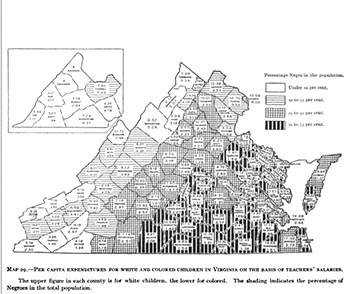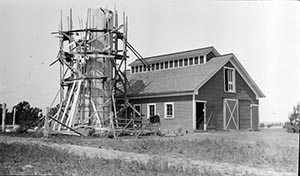Community
There is No Race Problem Here
An article in 1911 in the Manassas Journal boldly stated There Is No Race...Problem Here... however, the Manassas community seemed to be divided along racial lines despite a concerted effort being made by many whites and blacks in the community to downplay these antagonisms. This article was written as a part of an overall special series which was seeking to promote the locale of Manassas as a desirable place to both live and do business. The article continues, “The people of this section have settled the race problem in a common sense way by not having any problem to settle...The man who would come here to forement discord and make trouble would be discountenanced, and probably asked to leave town by leading men of both races...” 1
This suggests that the two communities were actually unitary in their goals and attitudes but this becomes less certain when we consider the examples that the article provides to support its thesis. The examples that are given tend to support the notion that there is no race problem in Manassas as long as Blacks remember to stay in their assigned social place in the society.
The Numbers
The public school system in Northern Virginia was laughable, especially for Black students. The five counties in the Northern Virginia area received very small amounts of state dollars for the purposes of education. Blacks, although they were entitled to half of the monies that were being allocated, received considerably less.

United States. Office of Education,
Thomas Jesse Jones, and Phelps-Stokes Fund,
Negro education (Govt. Print. Off., 1917).
Prince William County had limited elementary educational facilities and no public schools at the secondary level. Prince William county had 2660 white children and 42 schools, a mean ratio of about 63 students per school. Whereas the black community had 1110 students and only 12 schools which comes to a mean ratio of 92.5 students per school. This was skewed even more depending upon where you lived. For example, Brentsville had to accommodate 111 students with its single school.
Extended Communities
Local African American Community
The School served as a magnet for the local African American community of Manassas. The community provided what forms of aid they could afford to their school. They contributed with furniture and food stuffs but they also contributed to the school through their support of school events and sponsored programs.
Barn and Silo Construction
Manassas Industrial School-UVA This participation can be seen in the support of school picnics, which were both social events as well as fund raising events, school athletics, and sponsored programs like agricultural associations for colored people. Later this support would become crucial for Jennie Dean’s position in the bureaucratic structure of the school itself as well as to combat the ideas of the southern whites and the northern philanthropic interests who wanted to model MIS along the line of Hampton-Tuskegee.
Though we only have scattered pieces of evidence to support the idea of Black community spirit there is enough to suggest that it did exist. The Manassas Quarterly Bulletin, a newsletter of the school, shows the importance of the Negro Farmers Conference to the community.
Outside Communities
Very few of the students actually lived in Manassas. According to the last reliable lists of students that is currently available, we see that between 1898-1916 only 46 of the 499 students (roughly 9%) were from Manassas. By the time of the 1915-1916 term 59% of the student body was from out-of-state or out of the immediate area. Many of the students were from the surrounding areas and could have easily made the trek to the school via wagon or other form of transportation besides the railroad, however, some students were from distant parts of the state and even from out of state. For them riding on a train must have provided them with a new found form of freedom which would have been an exciting experience despite any anxieties they may have felt.
Some students were specifically attracted to the school because of its notoriety for training teachers, even before the school had started to expand into a major institution. In 1898 T. Taliafero, a graduate of the Howland school, wrote a letter to Ms. Howland which identified her desire to become a teacher and attend their summer institute program. I am waiting to hear from Manassas...I can’t bear the thought having to spend an idle vacation... - Taliafero to Howland-Emily Howland Papers. Cornell University She believed that she would be a more marketable candidate if she attended the Manassas program. Taliafero writes, “I am waiting to hear from Manassas...I can’t bear the thought having to spend an idle vacation...” Even as early as 1894 a teacher at Talladega college in Alabama sought assistance from Emily Howland to receive an appointment as a teacher at the new school that would be opened in Manassas. She had already taught for three years at Talladega and she sought to return to the Northern Virginia area which appears to have been her home.
1“There is No Race Problem Here,” Manassas Journal, May 19, 1911.
2ibid
(Back to top)NEXT
